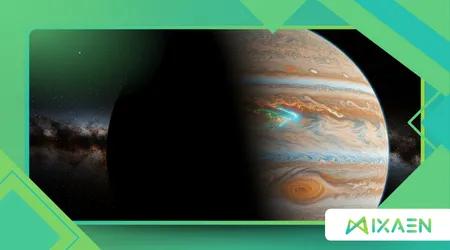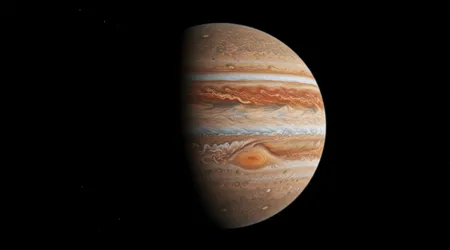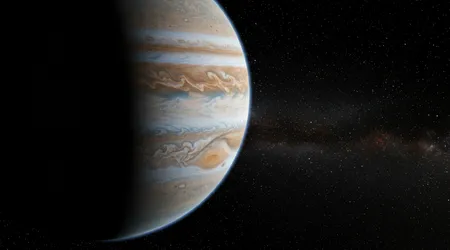Could Gas Giants Like Jupiter Hide Floating Ecosystems?

Could Gas Giants Like Jupiter Hide Floating Ecosystems? This question sparks endless curiosity among astronomers and dreamers alike. We gaze at Jupiter’s swirling storms, wondering if hidden worlds thrive within.
Anúncios
Jupiter dominates our solar system as the largest planet. Its massive atmosphere stretches deep, layered with gases that could hold secrets.
Scientists probe these layers actively. They seek signs of habitability far from solid ground. Recent missions reveal water vapor in Jupiter’s clouds. This essential ingredient fuels speculation about life.
Imagine ecosystems drifting like airborne islands. Organisms might evolve to float indefinitely. Yet, challenges abound. Extreme pressures crush deeper zones quickly. We explore this idea further. Let’s dive into the science behind it.
The Enigmatic Atmospheres of Gas Giants
Gas giants boast thick envelopes of hydrogen and helium. Jupiter’s atmosphere extends over 5,000 kilometers downward.
Winds whip at 500 kilometers per hour. Storms rage larger than Earth itself. Layers vary dramatically. Upper regions freeze at -145°C, but warmth builds below.
At certain depths, temperatures hit room level. Pressure mimics Earth’s surface here. Ammonia clouds form crystals. Water droplets mingle in lower strata.
Organic compounds appear. Methane and hydrocarbons react under lightning. These elements mirror prebiotic soups on early Earth. They hint at chemical evolution.
Probes like Juno map these zones. Data shows dynamic mixing of materials. Could Gas Giants Like Jupiter Hide Floating Ecosystems? Theorists argue yes, if buoyancy allows survival.
++ Are We Looking for Alien Life in the Wrong Way?
Microbes on Earth live in clouds. They metabolize aerosols high above. Similar adaptations might occur. Floating colonies could cycle nutrients vertically.
Predators might hunt in packs. Prey evolves camouflage in gas swirls. We picture balloon-like beings. Their sacs fill with lighter gases.
Such forms maintain altitude. They avoid crushing depths below. Energy sources vary. Chemical reactions power metabolism without sunlight.
Lightning provides sparks. Thermal gradients drive convection currents. Ecosystems balance delicately. One shift disrupts the chain.

Historical Theories and Pioneering Ideas
Carl Sagan sparked this debate decades ago. He collaborated with Edwin Salpeter in 1976. They proposed “floaters” jellyfish-like creatures drifting in Jupiter’s skies.
“Sinkers” fall and rise cyclically. “Hunters” prey on both actively. Their paper detailed plausible biochemistries. Ammonia-based life fits the environment.
Published in The Astrophysical Journal Supplement Series, it remains influential. Sagan drew from Venus studies. Acidic clouds there inspired similar thoughts.
For Jupiter, water clouds offer milder spots. Life might thrive at 1 bar pressure. Salpeter calculated densities. Organisms need low mass to float.
Also read: What If the First Alien We Find Is Just a Microbe?
He estimated sizes up to kilometers wide. Buoyancy keeps them aloft. Critics dismissed it as fantasy. But data evolved since then.
Could Gas Giants Like Jupiter Hide Floating Ecosystems? Sagan’s vision persists in modern models. Analogous to ocean plankton, floaters harvest chemicals. They reproduce via spores.
Hunters use jets for propulsion. They chase in turbulent flows. This hierarchy mimics Earth’s food webs. Complexity arises from simple rules.
We adapt these ideas today. Simulations test evolutionary paths. One example: A floater colony forms symbiotic bonds. They share gases for stability.
Another: Hunters develop sensors for ammonia gradients. They navigate storms efficiently. These scenarios ground speculation. They draw from real biology.
Modern Insights from Space Missions
NASA’s Juno orbited Jupiter since 2016. It dives close to clouds repeatedly. In 2021, it detected water abundance. About 0.25% in equatorial regions.
This matches models for habitable zones. Life needs liquid water potentially. Juno’s microwave radiometer peers deep. It reveals ammonia distribution patterns.
Storms mix layers vigorously. Nutrients circulate like ocean currents. Extended mission through 2025 yields more data. Lightning maps show energy hotspots.
Europa Clipper launches in 2024. It focuses on moons, but informs giant studies. JUICE mission from ESA arrives in 2031. It probes deeper atmospheres.
Could Gas Giants Like Jupiter Hide Floating Ecosystems? Missions hint at possibilities. Recent exoplanet finds expand views. Hot Jupiters orbit close to stars.
Read more: The TRAPPIST-1 System: A Real-Life Sci-Fi Neighborhood
Webb Telescope spots atmospheres. Carbon dioxide appears in some. A 2024 study in Nature Astronomy analyzed WASP-39b. It found sulfur dioxide from photochemistry.
This suggests active chemistry. Similar processes might foster life. For free-floating planets, Webb data from 2025 shows cloud variations.
These rogue worlds lack stars. Yet, internal heat sustains atmospheres. Statistics reveal over 5,000 confirmed exoplanets. Many are gas giants.
One in four systems hosts them. This boosts odds for hidden life. We compare to Earth’s extremophiles. Bacteria survive in acidic hot springs.
Potential for Life: Building Blocks and Habitats
Essential elements abound in gas giants. Hydrogen fuels basic reactions. Phosphorus hides in deeper rocks. But upwelling brings it up.
Carbon cycles through methane. Nitrogen forms ammonia readily. Habitats form in stable belts. Equatorial zones offer calm pockets.
Turbulence creates niches. Organisms adapt to shear forces. Could Gas Giants Like Jupiter Hide Floating Ecosystems? Building blocks suggest yes.
Consider microbial mats floating. They photosynthesize using infrared light. No, sunlight dims deep. Chemosynthesis dominates instead.
Bacteria oxidize hydrogen sulfide. Energy yields support chains. Larger forms evolve membranes. They filter toxins effectively.
Symbiosis enhances survival. Floaters host microbes for digestion. Diversity blooms in gradients. Species specialize by altitude.
Challenges include radiation. Jupiter’s magnetosphere traps particles. Belts expose life to doses. Evolution selects resistant strains.
We analogize to Earth’s atmosphere. High-altitude balloons carry life forms. Like those, Jovian beings drift eternally. They never touch ground.
What if life defies solid surfaces? This question redefines habitability. Practical example: A storm churns nutrients. Floaters feast post-event.
Another: Seasonal shifts alter densities. Ecosystems migrate vertically.
Challenges and Skepticism

Skeptics highlight crushing pressures. Below 10 bars, structures collapse. Temperatures soar to thousands degrees deeper. No life withstands that.
Radiation belts fry electronics. Biology fares worse. Nutrient scarcity poses issues. Trace elements might lack.
Could Gas Giants Like Jupiter Hide Floating Ecosystems? Doubts persist amid evidence. Detecting signs proves tough. Biosignatures mix with abiotic signals.
Phosphine on Venus sparked debate. Similar for Jupiter’s ammonia. Models predict disequilibrium gases. Life alters atmospheric chemistry.
Yet, geology mimics this. Volcanoes release odd compounds. Future probes need spectrometers. They analyze from orbit safely.
In-situ sampling risks destruction. Balloons could descend controlled. International teams collaborate now. They simulate conditions in labs.
Earth analogs help. Stratospheric sampling informs models. One statistic: Jupiter’s Great Red Spot lasts centuries. Stability aids ecosystems.
Despite hurdles, curiosity drives on. Discoveries await bold explorers.
| Atmospheric Layer | Altitude (km above 1 bar) | Temperature (°C) | Main Composition | Potential for Life |
|---|---|---|---|---|
| Troposphere (Upper) | 50 to 100 | -145 to -100 | Hydrogen, Helium | Low – Too cold |
| Troposphere (Middle) | 0 to 50 | -50 to 0 | Ammonia clouds | Moderate – Water possible |
| Troposphere (Lower) | -50 to 0 | 0 to 100 | Water clouds | High – Habitable temps |
| Stratosphere | 100 to 300 | -100 to -50 | Methane, Hydrocarbons | Low – UV radiation |
| Thermosphere | Above 300 | >100 | Ionized gases | None – Extreme heat |
This table summarizes Jupiter’s atmospheric layers based on Juno mission data.
Conclusion
We’ve journeyed through Jupiter’s mysteries. From Sagan’s dreams to Juno’s revelations, possibilities tantalize.
Could Gas Giants Like Jupiter Hide Floating Ecosystems? The answer leans toward maybe, with more probes needed.
Exoplanets multiply discoveries. Each new world challenges assumptions. Life might flourish in unexpected realms. Floating worlds redefine existence.
As technology advances, we edge closer. Telescopes peer deeper daily. Imagine confirming alien floaters. It transforms our cosmic view.
Human ingenuity pushes boundaries. We stand on discovery’s brink. This exploration ignites wonder. Keep watching the skies.
Frequently Asked Questions
What evidence supports life in gas giants? Theories from Sagan and Salpeter, plus Juno’s water detection, fuel speculation.
How could organisms survive without solid ground? By floating via buoyancy, like balloons, metabolizing atmospheric chemicals.
Are there real missions exploring this? Juno provides data; future ones like JUICE will dive deeper.
What challenges detection? Extreme conditions and ambiguous biosignatures complicate searches.
Could humans ever visit these ecosystems? Unlikely due to pressures, but robotic probes might sample.
